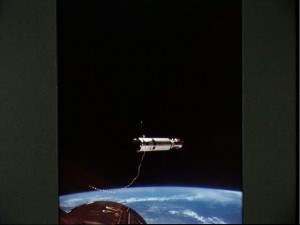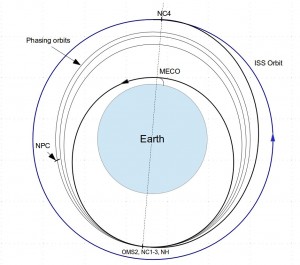Rendezvous and Docking: A Guide for Non Rocket Scientists
My latest article is now online at Baen Books: Rendezvous and Docking (Part 1): A Guide for Non Rocket Scientists.
How do you convince two spacecraft, travelling some 18,000 mph, hundreds of miles in space, to nuzzle together as gently as a bumblebee alighting on a nectar-laden hibiscus?
If you’re curious, or insomniatic, check it out. You’ll even learn how to win the first Zero-Gravity Super Bowl!
But be warned: it’s not called “rocket science” for nothing.


I liked this article – it showed me that it was more complicated than I had thought.
Hi Terry! Just found your blog and article about the MOCR. You had me and Ted laughing pretty hard. Those poor GCs! I’ll be watching for more of your work. I just published my space shuttle memoir, A Passion for Space, with Springer. You are in the photo of the FDOs on page 156, but I’m sorry I spelled your name wrong! (Burleson vs. Burlison.) You can find out more on my website or search my name on Amazon. In regards to your MCC history, the Trench may have owned ascent and entry, but the FAOs got the orbit!
Thanks, Marianne! Say “Hi” to Ted for me.
Terry, I got here from your Baen article about MOCR. I’ve been working on a nuts-bolts-and-rivets book about Mission Control, and finally had the time to enjoy your article.
One thing: you said that the console displays ” are rather like 1960s black-and-white TVs, only smaller and with fuzzier pictures.”
Actually they WERE B&W TVs. They were standard Philco portable TV chassis mounted in 19″rack trays. Remember that, at the time, TV tuners were a whole, big, dusty separate mechanical assembly, so for such uses as CCTV, station master control, camera viewfinders, etc, they just didn’t bother installing tuners.
The fuzzier pictures were courtesy of the interface between the data source and the display. Can’t blame Philco for that one, any more than we can blame LG for the garbage which is now called “programming” on TV . . .
Keith
One other thing: The change from Push Button Indicators to the touchscreen DVIS saved a HUGE amount of money, so the bean-counters were ecstatic.
No matter how sucky they are.
In 1963, each of the PBIs in your 48-line voice comm panel cost about two bucks. The switch legends were usually computer printouts, cut from a 36-inch tractor-paper sheet and inserted under the plastic screen. Each PBI has up to 22 separate terminals, to which wires are soldered (and those wires terminate in connectors or bus strips). 8 of those terminals are just for the itty-bitty bulbs inside, the others are for the actual switches (4ea, with three terminals per switch) and two grounding lugs.
If a PBI went bad, the whole panel was swapped out. The bad panel went to depot level maintenance. If the switch had to be replaced, the whole array might have to be taken apart to make it possible to pull the one switch, and you can pretty much bet that they tested all of the others in the array (so that they wouldn’t be doing the same thing to the same panel a week after it was installed into a console).
That was bad enough when the PBIs were a couple of dollars each (complete). Somewhere along the way, all four of the companies who supplied them just simply stopped making the things.
Today, a New Old Stock PBI can sell for as much as TWO HUNDRED DOLLARS, depending how desperate the need.
The DVIS touchscreen has no romance, but it is about $20 worth of parts and a bad circuit board is just swapped out. The ONE thing which is a (possible) advantage from the controller’s point of view is that in the newest FCR design, the DVIS is on a swing arm (like the displays), so can be positioned where it’s the most convenient for the controller.
Personally, I’m not convinced that this is actually any kind of improvement, as it means that each time you use it, you have to hunt for it, while the old VC panels were in one spot so your muscle memory worked.
Keith
To replace a bad PBI
Cool information, Keith. Thanks for posting!
Hi Terry
I just read your interesting article “Behind the Scenes at Mission Control”.
If possible, where can I get a copy (PDF ?) of “Flight Dynamics Officer Handbook” ?
Regards Bert Alm
Sorry, other than working there, I know of no way. 🙂